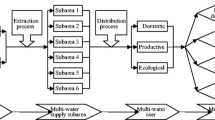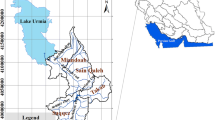Abstract
Efficient water allocation is one of the most prominent issues in water resources management. In this research, a two-stage interval-parameter stochastic fuzzy programming with type 2 membership functions was used to allocate water resources optimally to different users under uncertainty. This method can handle uncertainties expressed as probability distributions, discrete intervals, and fuzzy sets. The model considers treated wastewater as an allocable water resource in a scenario, in addition to water that is extracted from wellheads, springs, and qanats. Moreover, the loss rate of water during distribution, surplus water in the reservoir in the previous and the next period, and treated wastewater parameters have been incorporated into the model. This model was applied to a case study of water resources allocation within a multi-user and multi-reservoir context in the Zarand region of Kerman, Iran. The results indicate that reasonable solutions have been generated, in the form of interval and fuzzy information under different scenarios that could help managers provide optimal water resources allocation plans. The results also demonstrate that establishing a wastewater treatment station increases the system net benefits, surplus water in wellheads for the next period, and system reliability (level of satisfying the fuzzy goal and constraints), and decreases encountering water shortages.






Similar content being viewed by others
References
Ahmed, S., King, A. J., & Parija, G. (2003). A multi-stage stochastic integer programming approach for capacity expansion under uncertainty. Journal of Global Optimization, 26(1), 3–24.
Birge, J. R., & Louveaux, F. V. (1988). A multicut algorithm for two-stage stochastic linear programs. European Journal of Operational Research, 34(3), 384–392.
Dogra, P., Sharda, V. N., Ojasvi, P. R., Prasher, S. O., & Patel, R. M. (2014). Compromise programming based model for augmenting food production with minimum water allocation in a watershed: a case study in the Indian Himalayas. Water Resource Management, 28(15), 5247–5265.
Dong, C., Huang, G., Cheng, G., & Zhao, S. (2018). Water resources and farmland management in the Songhua River watershed under interval and fuzzy uncertainties. Water Resources Management, 32(13), 4177–4200.
Fan, Y. R., Huang, G. H., Guo, P., & Yang, A. L. (2011). Inexact two-stage stochastic partial programming: application to water resources management under uncertainty. Stochastic Environmental Research and Risk Assessment, 26, 281–293.
Fan, Y., Huang, G., Huang, K., & Baetz, B. W. (2015). Planning water resources allocation under multiple uncertainties through a generalized fuzzy two-stage stochastic programming method. IEEE Transactions on Fuzzy Systems, 23(5), 1488–1504.
Ferrero, R. W., Rivera, J. F., & Shahidehpour, S. M. (1998). A dynamic programming two-stage algorithm for long-term hydrothermal scheduling of multireservoir systems. IEEE Transactions on Power Systems, 13(4), 1534–1540.
Fu, Q., Zhao, K., Liu, D., Jiang, Q., Li, T., & Zhu, C. (2016). Two-stage interval-parameter stochastic programming model based on adaptive water resource management. Water Resources Management, 30(6), 2097–2109.
Guo, P., Huang, G. H., Zhu, H., & Wang, X. L. (2010). A two-stage programming approach for water resources management under randomness and fuzziness. Environmental Modelling and Software, 25(12), 1573–1581.
Hu, Z., & Hu, G. (2018). A multi-stage stochastic programming for lot-sizing and scheduling under demand uncertainty. Computers & Industrial Engineering, 119, 157–166.
Huang, G. H., Baetz, B. W., & Party, G. G. (1993). A grey fuzzy linear programming approach for municipal solid waste management planning under uncertainty. Civil Engineering Systems, 10(2), 123–146.
Huang, G. H., Baetz, B. W., & Patry, G. G. (1995). Grey integer programming: an application to waste management planning under uncertainty. European Journal of Operational Research, 83(3), 594–620.
Huang, G. H., & Loucks, D. P. (2000). An inexact two-stage stochastic programming model for water resources management under uncertainty. Civil Engineering and Environmental Systems, 17, 95–118.
Ji, L., Sun, P., Ma, Q., Jiang, N., Huang, G. H., & Xie, Y. L. (2017). Inexact two-stage stochastic programming for water resources allocation under considering demand uncertainties and response—A case study of Tianjin, China. Water, 9(6), 414.
Li, Y. P., & Huang, G. H. (2008). IFMP: Interval-fuzzy multistage programming for water resources management under uncertainty. Resources, Conservation and Recycling, 52, 800–812.
Li, W., Wang, B., Xie, Y. L., Huang, G. H., & Liu, L. (2015). An inexact mixed risk-aversion two-stage stochastic programming model for water resources management under uncertainty. Environmental Science and Pollution Research, 22(4), 2964–2975.
Liu, D., Liu, W., Fu, Q., Zhang, Y., Li, T., Imran, K. M., et al. (2017). Two-stage multi-water sources allocation model in regional water resources management under uncertainty. Water Resources Management, 31(11), 3607–3625.
Loucks, D. P., Stedinger, J. R., & Haith, D. A. (1981). Water resource systems planning and analysis. Englewood Cliffs: Prentice-Hall.
Maqsood, I., Huang, G. H., & Scott Yeomans, J. (2005). An interval-parameter fuzzy two-stage stochastic program for water resources management under uncertainty. European Journal of Operational Research, 167, 208–225.
Parisio, A., & Jones, C. N. (2015). A two-stage stochastic programming approach to employee scheduling in retail outlets with uncertain demand. Omega, 53, 97–103.
Pereira, M. V. F., & Pinto, L. M. V. G. (1985). Stochastic optimization of a multireservoir hydroelectric system: a decomposition approach. Water Resources Research, 21(6), 779–792.
Pereira, M. V., & Pinto, L. M. (1991). Multi-stage stochastic optimization applied to energy planning. Mathematical Programming, 52(1–3), 359–375.
Seifi, A., & Hipel, K. W. (2001). Interior-point method for reservoir operation with stochastic inflows. Journal of Water Resources Planning and Management, 127(1), 48–57.
Shao, L. G., Qin, X. S., & Xu, Y. (2011). A conditional value-at-risk based inexact water allocation model. Water Resources Management, 25, 2125–2145.
Shiklomanov, I.A. (1998). In World water resources: A new appraisal and assessment for the 21st century: A summary of the monograph World water resources. UNESCO.
Shukla, S., & Gedam, S. (2018). Evaluating hydrological responses to urbanization in a tropical river basin: A water resources management perspective. Natural Resources Research. https://doi.org/10.1007/s11053-018-9390-7.
Sophocleous, M. (2004). Global and regional water availability and demand: Prospects for the future. Natural Resources Research, 13(2), 61–75.
Tajeddini, M. A., Rahimi-Kian, A., & Soroudi, A. (2014). Risk averse optimal operation of a virtual power plant using two stage stochastic programming. Energy, 73, 958–967.
Wang, D., & Adams, B. J. (1986). Optimization of real-time reservoir operations with markov decision processes. Water Resources Research, 22(3), 345–352.
Wang, S., & Huang, G. H. (2013). An interval-parameter two-stage stochastic fuzzy program with type-2 membership functions: an application to water resources management. Stochastic Environmental Research and Risk Assessment, 27(6), 1493–1506.
Wang, S., & Huang, G. H. (2015). A multi-level Taguchi-factorial two-stage stochastic programming approach for characterization of parameter uncertainties and their interactions: an application to water resources management. European Journal of Operational Research, 240(2), 572–581.
Wang, S., Huang, G. H., & Zhou, Y. (2016). A fractional-factorial probabilistic-possibilistic optimization framework for planning water resources management systems with multi-level parametric interactions. Journal of Environmental Management, 172, 97–106.
Watkins, D. W., McKinney, D. C., Lasdon, L. S., Nielsen, S. S., & Martin, Q. W. (2000). A scenario-based stochastic programming model for water supplies from the highland lakes. International Transactions in Operational Research, 7(3), 211–230.
Xie, Y. L., Huang, G. H., Li, W., Li, J. B., & Li, Y. F. (2013). An inexact two-stage stochastic programming model for water resources management in Nansihu Lake Basin, China. Journal of Environmental Management, 127, 188–205.
Xie, Y. L., Xia, D. H., Huang, G. H., & Ji, L. (2018). Inexact stochastic optimization model for industrial water resources allocation under considering pollution charges and revenue-risk control. Journal of Cleaner Production, 203, 109–124.
Yin, L., & Han, L. (2015). Risk management for international portfolios with basket options: A multi-stage stochastic programming approach. Journal of Systems Science and Complexity, 28(6), 1279–1306.
Zahiri, B., Torabi, S. A., Mohammadi, M., & Aghabegloo, M. (2018). A multi-stage stochastic programming approach for blood supply chain planning. Computers & Industrial Engineering, 122, 1–14.
Zeng, X. T., Li, Y. P., Huang, G. H., & Liu, J. (2017). Modeling of water resources allocation and water quality management for supporting regional sustainability under uncertainty in an arid region. Water Resources Management, 31(12), 3699–3721.
Zhang, L., & Li, C. Y. (2014). An inexact two-stage water resources allocation model for sustainable development and management under uncertainty. Water Resources Management, 28(10), 3161–3178.
Zhou, Y., Huang, G., Wang, S., Zhai, Y., & Xin, X. (2016). Water resources management under dual uncertainties: a factorial fuzzy two-stage stochastic programming approach. Stochastic Environmental Research and Risk Assessment, 30(3), 795–811.
Zimmermann, H. J. (1985). Fuzzy set theory and its applications., International Series in Management Science. Operations Research. Kluwer Boston: Nijhoff Publishing.
Acknowledgments
This research was supported by Kerman Regional Water Company under Grant 97/02.
Author information
Authors and Affiliations
Corresponding author
Rights and permissions
About this article
Cite this article
Khosrojerdi, T., Moosavirad, S.H., Ariafar, S. et al. Optimal Allocation of Water Resources Using a Two-Stage Stochastic Programming Method with Interval and Fuzzy Parameters. Nat Resour Res 28, 1107–1124 (2019). https://doi.org/10.1007/s11053-018-9440-1
Received:
Accepted:
Published:
Issue Date:
DOI: https://doi.org/10.1007/s11053-018-9440-1




